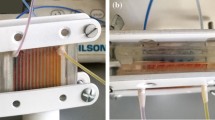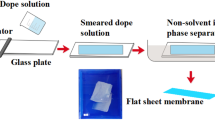Abstract
Polyarylsulfone group is one of the most important polymeric materials used in the biomedical field, due to its excellent properties, such as good thermal, chemical, and mechanical stability. There are three important polyarylsulfone polymers, all of which have excellent electrical properties: polysulfone (PSu), polyarylsulfone (PAS) and polyarylethersulfone (PAES). All these polymers have excellent creep, radiation and high temperature resistance. In this study, we aimed to determine the effect of three sterilization processes (steam, ethylene oxide and gamma rays) on cytotoxicity of polyarylsulfone dialysis membranes. Ten long-term dialysis patients and ten age-matched healthy controls were enrolled in our study. We analysed (1) serum effect on cultured endothelial cell viability using MTT assay and (2) lipid peroxidation assessed by serum malondialdehyde (MDA) formation at the beginning (T0), the middle (T2) and the end (T4) of haemodialysis (HD) session. Our results clearly showed that steam-sterilized membranes improve endothelial cell viability when compared to ethylene oxide or gamma rays-sterilized ones. Moreover, there is a increased generation of MDA in patients sera during HD session. The serum MDA concentration was about 3, 6 and 10 times higher, respectively, for steam, ethylene oxide and gamma rays sterilization procedures when compared to the MDA amount in healthy subject sera. We concluded that using steam instead of ethylene oxide or gamma rays for sterilization may improve the biocompatibility of polyarylsulfone membranes.





Similar content being viewed by others
Abbreviations
- PSu:
-
Polysulfone
- PAS:
-
Polyarylsulfone
- PAES:
-
Polyarylethersulfone
- MDA:
-
Malondialdehyde
- HD:
-
Haemodialysis
- ROS:
-
Reactive Oxygen species
- MTT:
-
3-(4,5-dimethylthiozol-2-yl)-2,5-diphenyltetrazolium-bromide
- TBA:
-
Thiobarbituric acid
References
Iseki K, Tozawa M et al (2003) Determinants of prescribed dialysis dose and survival in a cohort of chronic hemodialysis patients. Clin Exp Nephrol 7:231–237
Chan R, Brooks R et al (2009) The effects of kidney-disease-related loss on long-term dialysis patients’ depression and quality of life: positive affect as a mediator. Clin J Am Soc Nephrol 4:160–167
Hoenich NA (2007) Membranes for dialysis: can we do without them? Int J Artif Organs 30:964–970
Kummerle W, Heilmann K (1998) Importance of sterilisation procedures for extracorporeal devices. Blood material interaction. A basic guide from polymer science to clinical application. INFA, Glasgow, Krems, pp 100–105
Kawano Y, Logarezzi AJM (1995) X-ray induced degradation of regenerated cellulose membrane films. Polym Degrad Stab 50:125–130
Rodríguez-Benot A, Santamaría R et al (2002) Sterilization procedures and biocompatibility. Contrib Nephrol 137:138–145
Müller TF, Seitz M et al (1998) Biocompatibility differences with respect to the dialyzer sterilization method. Nephron 78:139–142
Aucella F, Tetta C et al (2002) Is steam sterilization really making any difference in dialysis-induced cytokine release? Int J Artif Organs 25:832–837
Koken T, Serteser M et al (2004) Changes in serum markers of oxidative stress with varying periods of haemodialysis. Nephrology 9:77–82
Droge W (2002) Free radicals in the physiological control of cell function. Physiol Rev 82:47–95
Pawlak K, Pawlak D et al (2007) Impaired renal function and duration of dialysis therapy are associated with oxidative stress and proatherogenic cytokine levels in patients with end-stage renal disease. Clin Biochem 40:81–85
Jackson P, Loughrey CM et al (1995) Effect of hemodialysis on total antioxidant capacity and serum antioxidants in patients with chronic renal failure. Clin Chem 41:1135–1138
Galli F, Canestrari F et al (1999) Pathophysiology of the oxidative stress and its implication in uremia and dialysis. Contrib Nephrol 127:1–31
Becker B, Himmelefarb J et al (1997) Reassessing the cardiac risk profile in chronic hemodialysis patients: a hypothesis on role of oxidant stress and other non-traditional cardiac risk factors. J Am Soc Nephrol 8:475–486
Gutteridge JMC (1995) Lipid peroxidation and antioxidants as biomarkers of tissue damage. Clin Chem 41:1819–1828
Craddock PR, Fehr J et al (1977) Hemodialysis leukopenia: pulmonary vascular leukostasis resulting from complement activation by dialyser cellophane membrane. J Clin Invest 59:879–888
Bonomini M, Reale M et al (1998) Serum levels of soluble adhesion molecules in chronic renal failure and dialysis patients. Nephron 79:399–407
Amore A, Bonaudo R et al (1995) Enhanced production of nitric oxide by blood dialysis membrane interaction. J Am Soc Nephrol 6:1278–1283
Sun W, Chen T et al (2007) A study on membrane morphology by digital image processing. J Memb Sci 305:93–102
Edgell CJ, McDonald CC et al (1983) Permanent cell line expressing human factor VIII-related antigen established by hybridization. Proc Natl Acad Sci USA 80:3734–3737
Mosman T (1983) Rapid colorimetric assay for cellular growth and survival. Application to proliferation and cytotoxicity assays. J Immunol Methods 65:55–63
Donker RB, Asgeirsdóttir SA et al (2005) Plasma factors in severe early-onset preeclampsia do not substantially alter endothelial gene expression in vitro. J Soc Gynecol Investig 12:98–106
Ohkawa H, Ohishi N et al (1979) Assay for lipid peroxide in animal tissues by thiobarbituric acid reaction. Anal Biochem 95:351–358
Hugue V, Kandoussi M et al (1996) Alteration of the lipid and apolipoprotein contents of lipoprotein (a) in haemodialysis patients. Nephrol Dial Transplant 11:825–829
Ramos R, Martínez-Castelao A (2008) Lipoperoxidation and hemodialysis. Metabolism 57:1369–1374
Barzin J, Feng C et al (2004) Characterization of polyethersulfone hemodialysis membrane by ultrafiltration and atomic force microscopy. J Memb Sci 237:77–85
Bélanger MC, Marois Y et al (2000) Selection of a polyurethane membrane for the manufacture of ventricles for a totally implantable artificial heart: blood compatibility and biocompatibility studies. Artif Organs 24:879–888
Vienken J, Diamantoglou M et al (1999) Artificial dialysis membranes: from concept to large scale production. Am J Nephrol 19:355–362
Silva AC, Rocha JBT et al (2007) Oxidative stress and d-ALA-D activity in chronic renal failure patients. Biomed Pharmacother 61:180–185
Voss P, Siems W (2006) Clinical oxidation parameters of aging. Free Radic Res 40:1339–1349
Himmelfarb J, Hakim RA (2003) Oxidative stress in uremia. Curr Opin Nephrol Hypertens 12:593–598
Jaffe JA, Liftman C et al (2005) Frequency of elevated serum aluminium levels in adult dialysis patients. Am J Kidney Dis 46:316–319
Santoro A, Ferrari G et al (1996) Ethylene-oxide and steam-sterilised polysulfone membrane in dialysis patients with eosinophilia. Int J Artif Organs 19:329–335
Aucella F, Vigilante M et al (1998) Reduction of mononuclear cytokine production in hemodialysis patients treated with steam-sterilized low-flux polysulphone membranes. Int J Artif Organs 21:210–215
Dastgir M, Peeva LG et al (2005) Stabilization of supported liquid membranes by γ-radiation and their performance in the membrane aromatic recovery system. Ind Eng Chem Res 44:7659–7667
Vázquez MI, de Lara R et al (2005) Modification of cellophane membranes by γ-radiation: effect of irradiation doses on electrochemical parameters. J Membr Sci 256:202–208
Shintani H, Nakamura A (1989) Analysis of a carcinogen, 4, 4′ methylenedianiline, from thermosetting polyurethane during sterilization. J Anal Toxical 13:354–357
Vàquez MI, Galàn P et al (2004) Effect of radiation and thermal treatment on structural and transport parameters for cellulose regenerated membranes. Appl Surf Sci 238:415–422
Zundorf J, Kremer S et al (2008) Formation of hydrogen fluoride by gamma and beta sterilisation in medical devices containing perfluoroheptane. Toxicology 243:284–293
Acknowledgements
This research was supported by «Le Ministère Tunisien de l’Enseignement Supérieur, de la Recherche Scientifique et de la Technologie (Laboratoire de Recherche sur les Substances Biologiquement Compatibles: LRSBC) ».
Author information
Authors and Affiliations
Corresponding author
Rights and permissions
About this article
Cite this article
Golli-Bennour, E.E., Kouidhi, B., Dey, M. et al. Cytotoxic effects exerted by polyarylsulfone dialyser membranes depend on different sterilization processes. Int Urol Nephrol 43, 483–490 (2011). https://doi.org/10.1007/s11255-009-9653-7
Received:
Accepted:
Published:
Issue Date:
DOI: https://doi.org/10.1007/s11255-009-9653-7




